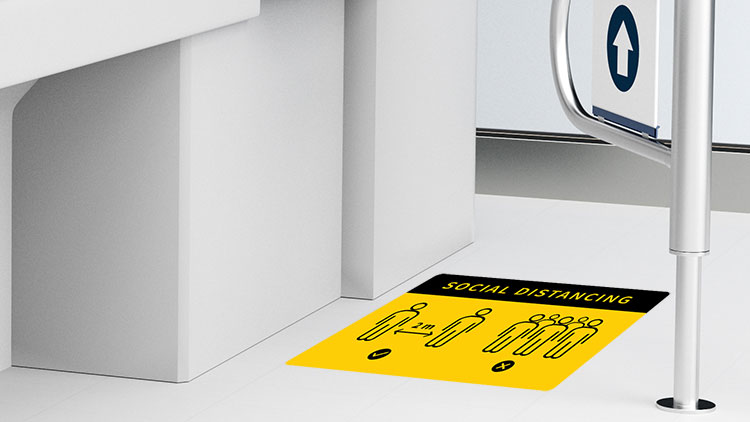Floor graphics are an effective tool in many scenarios and are increasingly used to guide the public around a space safely.
By reminding people to keep their distance, often acting as a visual barrier, floor graphics can play a key role in maintaining a safe but efficient flow of shoppers and other groups. However, if the intention is to protect people the last thing anyone wants is to create an injury risk.
To ensure floor graphics are appropriate for their setting, invest in the right product. When public safety is a priority, it's not enough to use any self-adhesive graphics media that sticks to the floor - only a product designed specifically for this application should be used. This, partly, is because it will have been tested and rated for its slip resistance.
The test standards used to measure slip resistance vary across different geographical regions and even within the same country. In the USA, ANSI A137.1/A326.3 is commonly referenced to but you will also see ASTM E303. In Europe, look for EN 13036-4 or DIN 51130. AS HB198:2014 and AS/NZS 4586 are used in Australia and New Zealand. Comparison between the standards is difficult as each will either differ slightly in test method or by using completely different instruments, but all are essentially measuring the same thing: floor friction.
These tables go into further detail and give some guidance on the recommended rating required for the intended environment. For example, with DIN 51130, slip resistance is measured with R ratings: an R9-rated product is only suitable for dry indoor areas such as offices; R10 would be suitable for areas that are kept mostly dry but have potential for spillages such as supermarket aisles, hospital corridors and warehouses; while R11 can be used in areas that can get wet like external walkways, bathrooms or serving areas. It is important to carefully consider all the conditions a floor graphic will be subjected to - and not just wet or dry situations. Contaminates like oil will affect floor friction more so than water, floors at a gradient are also different to level floors, and the amount or type of traffic endured by the graphic will impact the durability.
Fire ratings are also applicable to floor graphics. Ensure all products used in a public space have achieved a sufficient fire safety certification. The manufacturer or supplier of your selected floor graphics product will be able to tell you both the slip rating and fire rating - and to help you choose the right media for your specific environment.
Another reason for choosing a specialist floor graphics media is to avoid a trip hazard. These products will have been developed to adhere securely to most typical floor surfaces - but, again, check your intended setting - without tearing or curling at the edges. They may have been engineered to withstand heavy foot traffic, high-heeled shoes and machinery without being damaged. They should also be removed easily and cleanly without leaving sticky residue, which itself could pose a tripping risk.
It's important to keep floor graphics clean, and crucial if they display safety or directional information. Even with a specifically designed product, special care should be taken to minimise the adhesive's exposure to water and cleaning products as these can degrade the bond to the floor and create a tripping hazard. You can minimise the risk of lifting by edge-sealing the graphic upon application.
The print itself should withstand cleaning chemicals too - as well as potential fading from UV light - so check that the product is compatible with both your cleaning solutions and the ink technology used to print it.
Most specialist floor graphics films are designed for vibrant, long-lasting results with all major digital printing technologies.
Safety is paramount. If you have any questions or concerns, contact your product manufacturer or supplier for expert advice.
Authored by David Morgan, Technical Assistance, Drytac Europe
For further information on Drytac's products and services, please visit www.drytac.com





